How to upgrade your car's subwoofers & amplifiers
Learn how to upgrade your car's audio to achieve the best sound possible

How to upgrade your car's subwoofers and amplifiers
We've previously spoken about how to upgrade your car's head unit and speakers. In this article We'll go deeper and set you up with a next-level audio system, complete with separate amplifier and a subwoofer.
What we can't do is guide you step-by-step on how to install it all – there is a lot of work involved, including removing interior panels and carpet, wiring up fuses and grounds, running new power and speaker cables, mounting the amp and sub, and then tuning it all so that it sounds schmick. Now, these things can be done faster and neater (and with a warranty) by professionals, so we recommend deferring to them rather than undergoing this yourself.
If you're a mad-keen DIYer, though, you can find plenty of guides online, including this article from Crutchfield or this YouTube video by Geek Squad. We'd also recommend looking for forums specific to the make or model of your car to help with any specific cases.

Why Amplify?
We're sure you know why a subwoofer is beneficial – they go much deeper at much louder volumes than normal speakers – but few realise the benefits of externally amplifying your cabin speakers.
Obviously, an external amp will allow you to turn your music up much louder, as head units cannot (no matter what the box says) provide more than about 17W of power (it's a wiring limitation). However, the extra power reserves in larger amplifiers also allow your speakers to perform better at lower volumes, too.
This is because the bigger amp is better prepared for sudden changes in music and can deliver the required power much faster. Additionally, if you've chucked in for a mondo-mega 500W bass box, it doesn't really make much sense to have your speakers competing with only 17w of power.
Before we cover amplifier choices, though, let's look at subwoofers, as you're best off finding a subwoofer that meets your requirements, then pairing it with a suitable amp(s), rather than the other way around.
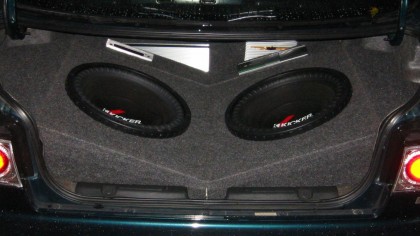
Subwoofers
When purchasing subwoofers, you can buy the driver (speaker) and buy/build the box separately, or buy a ready-made sub already fitted to a box. The former allows more flexibility in fitting the sub in your car (and the opportunity to create a bigger, better box if room permits), whereas the latter allows for a no-fuss drop-in solution. Note that drivers will have recommended box sizes/specs, so be sure that your chosen (or built) box meets those specs, lest you be neutering its performance.
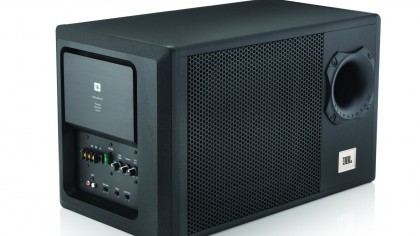
Subwoofers: Power rating
When choosing a subwoofer or driver, the primary concern is its power rating (measured in Watts [W]). To power the sub, you'll want an amp with at least as much power output as the RMS (not 'peak' or 'maximum') power rating of the driver. Obviously, the bigger the power requirements, the bigger the cost (expect good 500W drivers to cost about AU$300 (approx £139, US$215) without a box, and good 500W mono amplifiers to cost the same or more).
On that note, what wattage should you go for? Bigger is always better, right? Well, yeah, but is it worth spending the extra money on a 500W or 1000W 12" or larger subwoofer over a 250W 10" subwoofer? If you like the idea of people hearing you coming from blocks away, then yes. If you're happy with shouting volumes (as opposed to screaming), a 10" 200-300w sealed subwoofer should suffice.
It's worth noting that the wattage of a sub/amp is only a very rough guide to its performance – a well-designed 100W sub and enclosure can provide better and stronger bass than a poorly designed 300W sub and enclosure. Try before you buy.

Subwoofers: Sensitivity & frequency range
Looking down the spec sheet, you'll additionally notice many other numbers, of which the most crucial are:
The sensitivity of a driver, given in dB SPL (decibels of sound pressure level) at a specified impedance (in Ohms): the more sensitive a driver (the higher the number), the less power it needs to reach a given volume, so using more sensitive drivers can be a good way to get away with a lower-power (and therefore cheaper) amp. Just make sure you're comparing numbers at the same impedance.
You'll also want to look at the frequency range that a driver can output across, and ideally match it so that there is no gap between the frequencies handled by your main cabin speakers and the subwoofer. You'll set the frequencies actually reproduced by the speakers + sub via the crossover settings in your head unit or amplifier, but – for the greatest flexibility – you'll want a driver that overlaps with your cabin speakers.
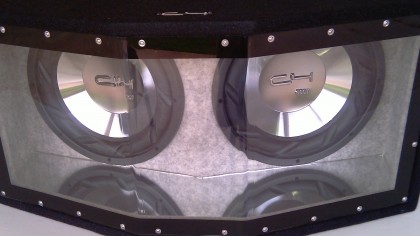
Subwoofers: Enclosures
When choosing a sub enclosure, you need to consider both the type of enclosure as well as its size. Enclosures can come in almost any size, but really only three types: sealed, ported, or bandpass.
Sealed boxes are airtight enclosures that provide the best quality bass, but are less efficient – so won't go as loud given the same power. Ported boxes have a little porthole in them where the sound can escape, which makes them louder at the cost of accuracy – some frequencies will be louder than others.
Bandpass boxes are a blend of the two (it's effectively a sealed sub within a ported box) that produce massive bass at specific frequencies – they are often used in show cars, as they go very loud, can look the part with Perspex windows, and can be tuned to output maximum bass across a frequency range complementary to a given type of music.
Space is the other crucial decision: there's no sense in selecting a subwoofer that won't fit in your car. Professional installers will take care of this decision for you – measuring and selecting (or building) a suitable sub box on your behalf – but if you want to bring your own, or install one yourself, first measure your available space before buying anything.
If space is at a premium – say, you drive a ute, convertible, or hatch-back – you can opt for extra-small enclosures for use behind or under the seats. You may even want to look for a slim-line sub enclosure that includes a built-in amp, saving you even more space.
Once you've chosen your sub, it's time to pair it to a suitable amplifier.

Amplifiers: Power
When selecting an amplifier, you first need to consider just how many speakers you want amplified – will you be powering just a sub, or also the cabin speakers? If you don't have a sub and just want to power the nice speakers you've installed in the cabin, then go for a two or four channel amp.
If you're also looking to power your subwoofer with the same amp, you can go for either a 2.1 channel amp, a four channel amp with two of the outputs 'bridged' (just make sure that the amp can be bridged), or a 5.1 channel amp (if you want to power the rear speakers, too, or have a movie player).
If you are keen on a larger (greater than 10" or 400W) subwoofer, or plan on installing multiple subs, you may be better off looking for a separate (or multiple) mono amp(s) for your subwoofer(s) alongside the two- or four-channel amp for your cabin speakers.
But just because you want multiple subs, doesn't mean you need multiple amps – a big 1000W amp will be able to power two 500W subs – just as long as you wire them correctly. When connecting multiple speakers/subs to a single output channel, you need to decide if you're going to wire them in series (increasing the load on the amp) or in parallel (decreasing the load). Such decisions are best left to professionals, but if you're embarking on this yourself, you should start by reading this guide here.
Further to this, when choosing an amp, more power is almost always better. So, if you have a 500W subwoofer, you're better off going for a 550W amp over a 450W or 500W one. If you plan on adding a second subwoofer later, you may even be better off getting a 1000W amp and turning the gain down at install to prevent damage to your sub.
If you're pairing a 200W amp to a 500W sub, you've wasted your money; you would have been better of spending it on a cheaper 300W subwoofer and better 300W amp.
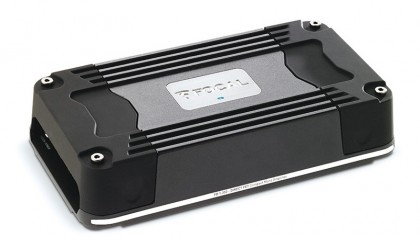
Amplifiers: Outputs & Filters
Of course, there are many more features than just power rating and channels on an amp, so we'll go through some of those options, too.
One of the most crucial factors when picking out an amp is finding out if your existing source/head unit has pre-amp outputs. Many factory units don't, so – if you're not replacing your stock head unit – you'll need to purchase an amp with speaker level-inputs rather than standard RCA inputs (or a line output converter).
Most amps come with high- or low-pass filters (aka crossover filters). What these do is filter out the lowest or highest frequencies in the signal before they are passed to your speakers and subwoofer, saving them from having to reproduce frequencies that they aren't very good at reproducing. This lightens the load on both the speakers and the amplifier, and allows your speakers to go a bit louder before they distort.
Most amps these days have variable (rather than fixed) high- and low-pass filters, which allow you to choose the frequency where your cabin speakers end and your subwoofer begins. There are also subsonic filters that cut out the lowest inaudible frequencies that may be generated by engine noise or other interference.
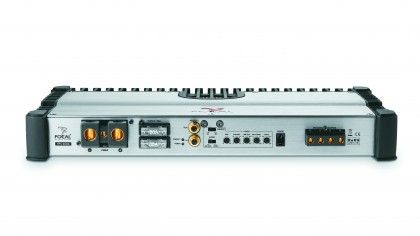
Amplifiers: Additional Features
Similarly, amps often come with built-in equalisers and tuning features. More expensive amps will come with more fine-grained controls for tuning the sound, but therefore also require greater knowledge and equipment to set up and get the most out of – yet another reason to turn to a professional installer.
Cheaper amps may come with something as simple as a 'bass boost' on/off switch, or nothing at all. Notably, if your head unit has separate pre-amp outputs for your subwoofer and speakers, it'll be able to take over the crossover duties, so the need for an amplifier with filters and EQ settings is diminished.
You may also see the 'class' of an amplifier mentioned on its spec sheet. For car audio, we don't think there's any reason to get anything other than class D (or the near-identical class T), as it's the most efficient – it generates less heat per watt of output. Audio purists will say that class A/B or class A will produce better sound, but the extra cost, size, weight, and ventilation requirements needed for such amps aren't worth the marginal (we'd argue imperceptible) difference in sound quality.
If space is a concern, there are smaller amplifiers available for tight installs, but they cost a little more due to the extra engineering required to create such a product. It's also paramount that you heed any ventilation requirements when measuring up the size of your mounting space.
If you're looking to connect multiple amps to your head unit, but it only has one pre-amp output, you will want to find an amp with pre-amp outputs, which will allow another amp to piggy back off of the audio signal (say, for your subwoofer).
These can be especially useful if you're connecting multiple amps up to a head unit with only speaker outputs – get one amp with speaker-level inputs and pre-amp outputs, then your other amp will only need standard RCA connectors.
Now it's time to start selecting components for your new system!